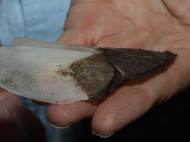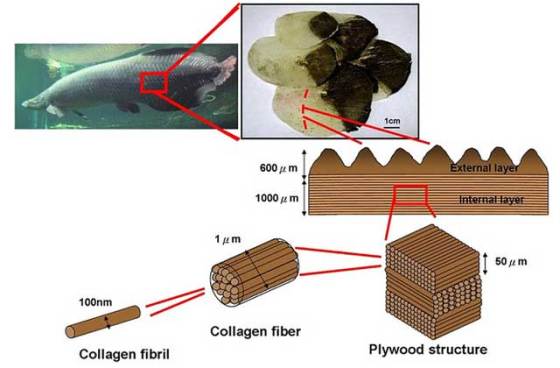Arapaima fish scales inspire new materials
 Inspired by massive Arapaima fish which lives in is Brazil’s Amazon waters, a group of researchers from UC San Diego are developing new materials suitable for armor and panels. Biomimicry of Arapaima’s complex scales could lead to new ceramics that are both tough and flexible, making them ideal for use in soldier’s body armor, fuel cells, insulation and aerospace designs.
Inspired by massive Arapaima fish which lives in is Brazil’s Amazon waters, a group of researchers from UC San Diego are developing new materials suitable for armor and panels. Biomimicry of Arapaima’s complex scales could lead to new ceramics that are both tough and flexible, making them ideal for use in soldier’s body armor, fuel cells, insulation and aerospace designs.
“We have used our ingenuity to the maximum, but one way to overcome that is to look at nature”, said Marc Meyers, a professor at the Jacobs School of Engineering at UC San Diego. “The materials that nature has at its disposal are not very strong, but nature combines them in a very ingenious way to produce strong components and strong designs.”
After an expedition in the Amazon basin he took years ago, Meyers wondered how Arapaima could live in piranha-infested lakes, where no other animals could survive piranha attacks.
Meyers and colleagues set up a lab experiment by using a machine that resembles an industrial-strength hole punch, where they attached piranha teeth to the top “punch” which was pressed down into Arapaima scales embedded in a soft rubber surface which mimics the soft underlying muscle on the fish. Although the teeth were able to partially penetrate the scale, they cracked before puncturing the muscle.
The Arapaima scale combines a heavily mineralized outer layer with an internal design that helps the scale resist the pirahna’s razor-like bite. The scales provide armor for the fish since it is overlap like shingles. Aside hard mineralized layer on top, each scale is composed of much softer collagen fibers stacked in alternating directions like a pile of plywood.
The grooved surface keeps the scales’ thick mineralized surface intact while the fish flexes as it swims. Ceramic surfaces of constant thickness are strained when forced to follow a curved surface, but the grooves allow the scales to be bent more easily without cracking.
The corrugations, the soft but tough internal layer and the hydration of the scales all contribute to their ability to flex while remaining strong. It’s an engineering solution that lets the fish remain mobile while heavily armored, and also allows the scales to bend and deform considerably before breaking.
FOr more information, read the paper published in the Journal of the Mechanical Behavior of Biomedical Materials: “Mechanical properties and the laminate structure of Arapaima gigas scales“.










Leave your response!